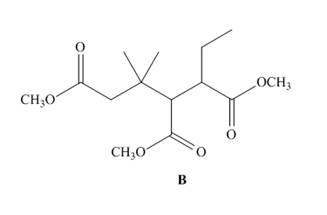
ORGANIC CHEMISTRY
5th Edition
ISBN: 9781259977596
Author: SMITH
Publisher: MCG
expand_more
expand_more
format_list_bulleted
Concept explainers
Textbook Question
Chapter 24, Problem 24.41P
Even though B contains three ester groups, a single Dieckmann product results when B is treated with

Expert Solution & Answer
Want to see the full answer?
Check out a sample textbook solution
Students have asked these similar questions
the decomposition of N2O5 is the first order with a half-life of 1.98 minutes. If the inital concentration of N2O5 is 0.200 M, what is the concentration after 6 minutes?a) 0.612 Mb) 0.035 Mc) 0.024 Md) 0.100 M
20.00 mL of 0.150 M HCI is titrated with 0.075 M NaOH. What volume of NaOH is needed?a) 50 mLb) 20 mLc) 40 mLd) 26.66 mL
20.00 mL of 0.150 M NaOH is titrated with 37.75 mL of HCI. What is the molarity of the HCI?a) 0.150 Mb) 0.079 Mc) 0.025 Md) 0.050 M
Chapter 24 Solutions
ORGANIC CHEMISTRY
Ch. 24 - Prob. 24.1PCh. 24 - Prob. 24.2PCh. 24 - Problem 24.3
What unsaturated carbonyl compound is...Ch. 24 - Prob. 24.4PCh. 24 - Prob. 24.5PCh. 24 - Prob. 24.6PCh. 24 - Problem 24.7
Draw the products formed in each...Ch. 24 - Problem 24.8
Draw the products formed in the...Ch. 24 - Prob. 24.9PCh. 24 - Prob. 24.10P
Ch. 24 - Prob. 24.11PCh. 24 - Prob. 24.12PCh. 24 - Prob. 24.13PCh. 24 - Prob. 24.14PCh. 24 - Prob. 24.15PCh. 24 - Problem 24.16
What ester is formed when each...Ch. 24 - Prob. 24.17PCh. 24 - Prob. 24.18PCh. 24 -
Draw the products of each reaction.
a. b.
Ch. 24 - Problem 24.20
Two steps in a synthesis of the...Ch. 24 - Prob. 24.21PCh. 24 - Problem 24.22
Which of the following compounds can...Ch. 24 - Prob. 24.23PCh. 24 - Problem 24.24
What starting materials are needed...Ch. 24 - Problem 24.25
Draw the products when each pair of...Ch. 24 - Prob. 24.26PCh. 24 - Problem 24.27
What starting materials are needed...Ch. 24 - Prob. 24.28PCh. 24 - 24.29 What steps are needed to convert A to B?
Ch. 24 - Prob. 24.30PCh. 24 - 24.31 Draw the product formed in each directed...Ch. 24 - Prob. 24.32PCh. 24 - 24.33 What starting materials are needed to...Ch. 24 - Prob. 24.34PCh. 24 - Prob. 24.35PCh. 24 - 24.36 Identify the structures of C and D in the...Ch. 24 - Prob. 24.37PCh. 24 - Prob. 24.38PCh. 24 - 24.39 Draw the product formed from a Claisen...Ch. 24 - Prob. 24.40PCh. 24 - 24.41 Even though B contains three ester groups, a...Ch. 24 - Prob. 24.42PCh. 24 - Prob. 24.43PCh. 24 - 24.44 Vetivone is isolated from vetiver, a...Ch. 24 - Draw the product of each Robinson annulation from...Ch. 24 - Prob. 24.46PCh. 24 - 24.47 Draw the organic products formed in each...Ch. 24 - 24.48 Fill in the lettered reagents needed for...Ch. 24 - Prob. 24.49PCh. 24 - Prob. 24.50PCh. 24 - Prob. 24.51PCh. 24 - 24.52 Draw a stepwise mechanism for the following...Ch. 24 - Prob. 24.53PCh. 24 - Prob. 24.54PCh. 24 - Prob. 24.55PCh. 24 - Prob. 24.56PCh. 24 - Prob. 24.57PCh. 24 - Prob. 24.58PCh. 24 - Prob. 24.59PCh. 24 - 24.60 Devise a synthesis of each compound from the...Ch. 24 - 24.61 Devise a synthesis of each compound from...Ch. 24 - 24.62 Devise a synthesis of each compound from ,...Ch. 24 - Prob. 24.63PCh. 24 - Prob. 24.64PCh. 24 - 24.65 Answer the following questions about...Ch. 24 - Prob. 24.66PCh. 24 - Prob. 24.67PCh. 24 - Prob. 24.68PCh. 24 - 24.69 Devise a stepwise mechanism for the...Ch. 24 - 24.70 Draw a stepwise mechanism for the following...Ch. 24 - Prob. 24.71PCh. 24 - Prob. 24.72PCh. 24 - Prob. 24.73P
Knowledge Booster
Learn more about
Need a deep-dive on the concept behind this application? Look no further. Learn more about this topic, chemistry and related others by exploring similar questions and additional content below.Similar questions
- in the following reaction, the OH- acts as which of these?NO2- (aq) + H2O (l) ⇌ OH- (aq) + HNO2 (aq)a) not a weak acidb) basec) acidarrow_forwardfind the pH of a buffer made from 0.20 M HNO2 and 0.10 M NaNO2. Ka= 4.0 x 10-4a) 4.00b) 3.40c) 3.70d) 3.10arrow_forwardthe Ka for sodium dihydrogen phosphate is 6.32 x 10-8. Find the pH of a buffer made from 0.15 M H2PO4- and 0.15 M HPO42-.a) 6.98b) 7.42c) 7.00d) 7.20arrow_forward
- Find the equilibrium concentration of H3O+ starting with 0.072 M solution of acetic acid. Ka = 1.8 x 10-5. Acetic acid is HC2H3O2 (aq).HC2H3O2 (aq) + H2O (l) ⇌ H3O (aq) + C2H3O2- (aq) a) 1.3 x 10-6 b) 1.1 x 10-3 c) 1.5 x 10-2 d) 3.6 x 10-5arrow_forwardin VSEPR Theory, AX2 isarrow_forwardcalculate the pH of 0.066 M Ca(OH)2. Remember stoichiometry.arrow_forward
- Find the equilibrium concentration of H3O+ starting with 0.072 M solution of acetic acid. Ka = 1.8 x 10-5. Acetic acid is HC2H3O2 (aq).HC2H3O2 (aq) + H2O (l) ⇌ H3O (aq) + C2H3O2- (aq)arrow_forwardin VSEPR Theory AX2 isa) tetrahedralb) octahedralc) lineard) trigonal bipyramidarrow_forwardCheck How many signals would you expect to find in the H NMR spectrum of each given compound? Part 1 of 2 Part 2 of 2 Br Br 2. Cl X 2 © 2025 McGraw Hill LLC. All Rights Resarrow_forward
arrow_back_ios
SEE MORE QUESTIONS
arrow_forward_ios
Recommended textbooks for you

Characteristic Reactions of Benzene and Phenols; Author: Linda Hanson;https://www.youtube.com/watch?v=tjEqEjDd87E;License: Standard YouTube License, CC-BY
An Overview of Aldehydes and Ketones: Crash Course Organic Chemistry #27; Author: Crash Course;https://www.youtube.com/watch?v=-fBPX-4kFlw;License: Standard Youtube License